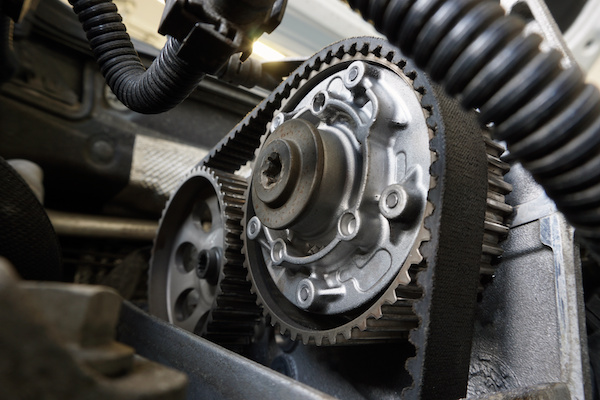Posted on 10/27/2022

It is a rubber loop that has ridges carved into it. It keeps them in synchronization by going around the teeth of the crankshaft, which connects to the pistons, and the camshaft, which regulates the valves. In other words, it controls the timing of the pistons' up-and-down movement to open and close valves. Most engines' valves and pistons are literally headed for collision if a belt isn't performing its job. Additionally, something may go wrong in an instant due to the engine's high rate of rotation. The worst-hit parts are the valves, which typically bend when the piston hits. However, the cylinder walls and piston may also be harmed. It entails severe engine damage and pricey repairs. Thankfully, it can also be prevented. On the side of the road, a gray car is parked, and someone is peering under the hood. For the manufacturer's advice on when to change your belt, consult your owner's manual. The majority of mechanics advise changing it between 60,000 and ... read more
Posted on 10/27/2022
It is important to check the fluids under your hood regularly. Sometimes it can be confusing under there and it is important to get the fluids into the right place. Colin and Pooh Bear walk you through what to look for in this video to take all the guesswork out of figuring out what fluid goes where. https://youtu.be/S_towp5Q0WM The fluids you should be checking at least once a month are: Oil Windshield wiper fluid Power steering fluid Brake Fluid Coolant Transmission Fluid- This may or may not be in your car. Some cars have an electric transmission, which does not need fluid. The reason for the monthly check is to catch a leak and to check the color and quality of the fluids. For warned is forearmed and catching things early can not only help your car but your wallet as well.
Posted on 10/20/2022
What is Power Steering? The Power Steering system of your car makes turning your car easy. If you have ever driven a classic car without power steering, you understand how hard it use to be. Also, without power steering, you use to have to accelerate to turn, like a Jet ski. Where is Power Steering located? The Power steering system is a part of a larger system, it goes from your steering wheel all the way to your tires. Long story short, that means to look under the front of your car for leaking. Sometimes there is a warning light that will go on if you are having an issue, but not always. These are signs that your power steering is going bad or is bad: Low on power steering fluid- this shows when turning gets harder to do. Also, it may start whining. Power steering pump or motor went bad- this is evident when you strain to turn your steering wheel or sound like high-pitched screaming Serpentine belt broken- The car may stall ( ... read more
Posted on 10/6/2022
How do you know if your transmission is bad?What is a transmission and where is it located? The nuts and bolts of it is that the transmission translates the power your engine makes to the wheels of our car. It manages the stop, go, and how fast your car moves. Where the transmission is depends on the make and model of the car, but it is usually in the front-middle of the car. So that is where to look for fluid leaking or where the sounds will usually be coming from. Transmissions usually need service around 60-90K. We take the guess work and the need to track these services off your plate and let you know when it’s time for such maintenances. What are signs that my Transmission is going?Sound: If you hear grinding, or like something is not catching when you change speeds, slow down, or come to a stop. Whining, humming, and clunking sounds are also indicators. Sight: Fluids ... read more